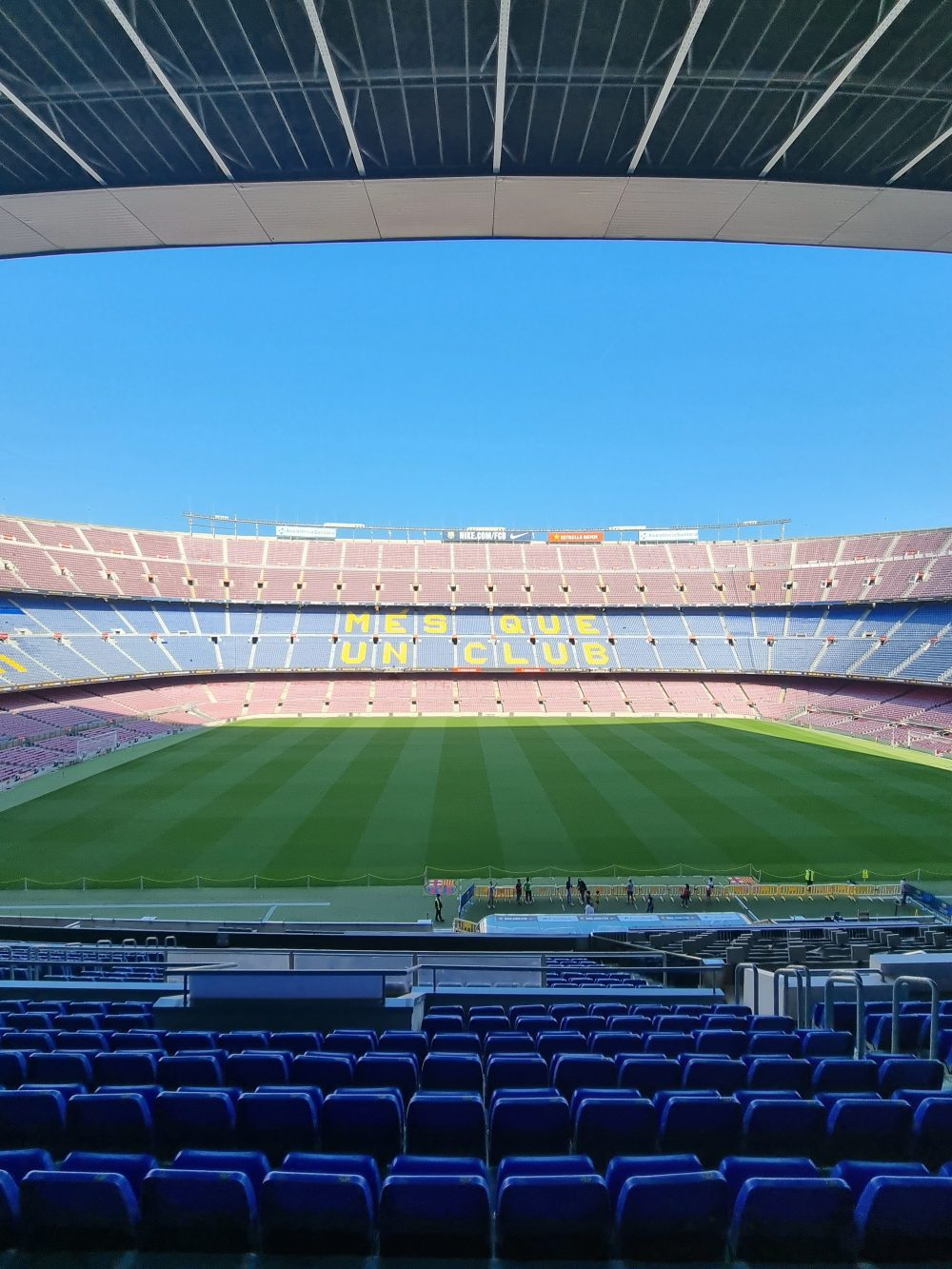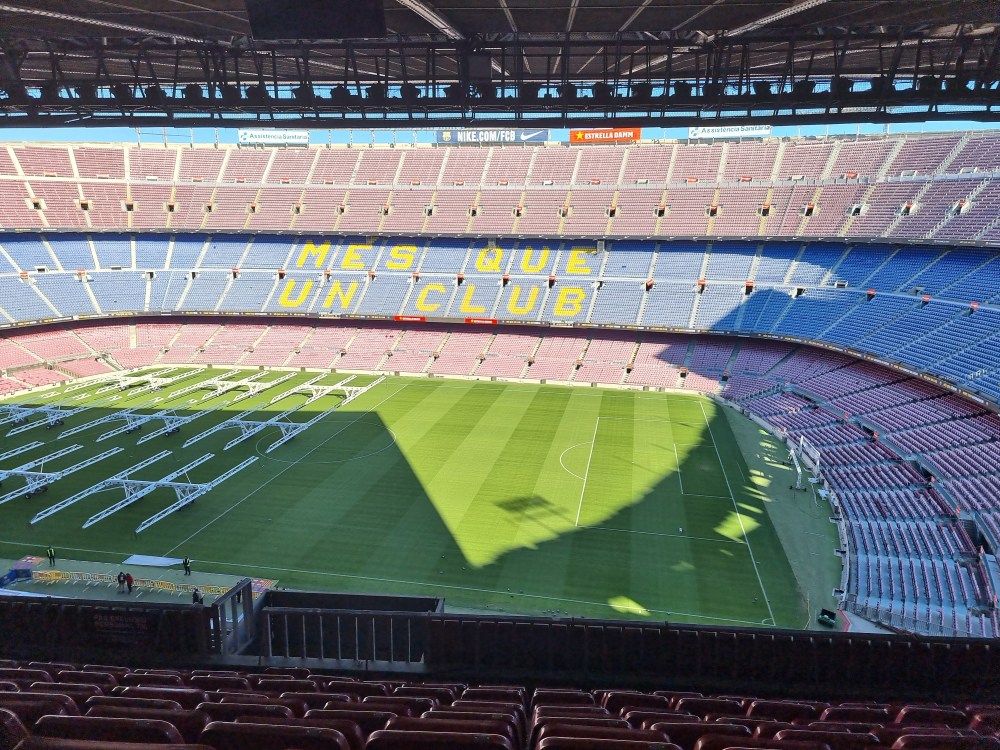FC Barcelona: History & Highlights
Throughout FC Barcelona’s history, the club has been recognized for its lovable and highly entertaining brand that always appeared to deliver results. They have won the La Liga and Copa del Rey championships a few times. They also won the Champions League and the Cup Winners’ Cup during this period.
As one of the world’s wealthiest and most popular teams, they can afford to be owned and funded only by their fans. The phrase “More than a club” (Més que un club) reflects on Barcelona’s status as a symbol of Catalonia and its culture from its origin. When Joan Gamper decided to start a football club in 1899, it was a huge step forward in the history of FC Barcelona. In response to his newspaper ad, eleven other people shared his ambition, forming Barça. If you’re a fan of the club or just intrigued by its fascinating history and the iconic stadium, we’d love to show you around during our Ultimate Barcelona: Private Full-day Tour or Barcelona Insider: Half Day Private Tour.

The powerful history of FC Barcelona

The history of FC Barcelona, often referred to as Barça, dates back to October 22nd, 1899, when Hans Kamper placed an advertisement in “Los Deportes” seeking individuals to form a soccer club. The first meeting took place on November 29th at Gimnasio Sole, attended by 11 players, including Walter Wild, the club’s first director.
Barcelona FC began its journey in regional and national cups, achieving success in the Campionat de Catalunya and Copa del Rey. In 1902, they won their first trophy, the Copa Macaya, and participated in the inaugural Copa del Rey, reaching the final but losing to Bizcaya 1-2.
Between 1905 and 1908, the club faced financial difficulties due to a lack of trophies. Hans Kamper, who had originally advertised to form the club, became its president on five occasions between 1908 and 1925. Kamper played a pivotal role in securing the club’s own stadium, Camp de la Industria, in 1909, with a seating capacity of 8,000.
During the early 1910s, Barcelona FC participated in the Pyrenees Cup, a prestigious competition featuring top teams from Southern France, Catalonia, and other regions. The club also transitioned from Castilian to Catalan as its official language, becoming a symbol of Catalan identity.

Joan Gamper, formerly Hans Kamper, initiated a campaign that led to 20,000 club members by 1922, helping finance a new stadium: Les Corts, which could hold up to 60,000 spectators. Jack Greenwell became FC’s Barcelona first full-time manager, improving the club’s fortunes. During the Gamper era, they won the Campionat de Catalunya eleven times, Copa del Rey six times, and four Pyrenees Cups.
From 1923 to 1957, FC Barcelona faced challenges, including the closure of their stadium for six months and Gamper’s forced resignation as president in 1925. The political situation during this period also influenced the club. In 1930, Gamper tragically committed suicide, and FC Barcelona continued to compete amid political tensions. The Spanish Civil War had a profound impact on the club, with several players enlisting to fight against the military uprising. Club president Josep Sunyol was murdered in 1936, a significant event in the club’s history.
A tour of Mexico and the United States in 1937 provided financial relief but led to several players seeking asylum abroad. Barcelona suffered aerial bombardment in 1938, with thousands of casualties, and Catalonia was occupied. The club was forced to change its name and remove the Catalan flag from its badge. Despite the political challenges, FC Barcelona achieved some success in the 1940s and 1950s, winning La Liga titles in 1943, 1948, and 1949. In 1952, they secured five trophies, including La Liga and the Copa del Generalísimo.
From 1957 to 1978, FC Barcelona continued to compete but faced periods of success and challenges. They won La Liga and the Inter-Cities Fairs Cup in 1960 and the Copa del Generalísimo in 1968. The end of Franco’s dictatorship in 1974 led to the club reverting to its original name and badge. In 1973-74, Johan Cruyff arrived, bringing success to FC Barcelona. Under his leadership, the club won La Liga and the Copa del Rey, and Cruyff became European Player of the Year twice. His tenure marked the beginning of a new era.
From 1978 to 2000, FC Barcelona experienced changes in leadership and player acquisitions. Notably, Diego Maradona joined the club in 1982, and Terry Venables led the team to La Liga success in 1984-85. However, internal conflicts and managerial changes affected the club during this period. In 2000, Joan Gaspart became the club president, overseeing a period of decline. Luis Figo’s controversial transfer to Real Madrid further strained relations between the clubs. FC Barcelona struggled to maintain success during these years.
In 2008, Pep Guardiola took over as manager, implementing a new style of play and emphasizing youth development. Under his leadership, FC Barcelona achieved remarkable success, winning La Liga, the Copa del Rey, and the Champions League, including a historic treble in 2008-09. Guardiola continued to lead the team to more titles, including another Champions League victory in 2011. Barcelona FC became known for its tiki-taka style of play and enjoyed a period of dominance in Spanish and European football. In 2012, Guardiola stepped down, and Tito Vilanova took over as manager. The club continued to compete at a high level, although success in the Champions League eluded them.
The dawn of a new age of dominance has arrived

Barcelona’s aspirations were dealt a severe setback in 2000 when “Los Galacticos” from Real Madrid signed Luis Figo, one of the club’s all-time heroes. When Frank Rijkaard arrived at the club in 2005, things finally began to improve for the better. Ronaldinho, Carles Puyol, Xavi, and Andres Iniesta are only a few of the stars that Rijkaard assembles in his squad, much as his predecessors Cruyff and Van Gaal did before him. Rijkaard led Barcelona to two La Liga titles and one Champions League trophy during his time in command.
Having previously served as head coach of Barcelona’s B Team, Pep Guardiola assumed control of the club in 2008. Guardiola was a product of La Masia himself, and he well grasped the Academy’s value and the potential it carries. A style of play that coupled Cruyff’s love of rapid passing and frequent movement with a desire to keep possession at all costs was the centerpiece of his coaching philosophy. This new strategy, called “tiki-taka”, also preferred zonal marking over the conventional, formation-based strategy in this technique. A conceptual revolution was born from tiki-taka, and Barcelona was in the best position to benefit from it.
Guardiola transformed Barcelona into the most powerful club in the world during his four years in charge. Lionel Messi led Barcelona to three La Liga titles, two Copa del Reys, and two Champions League crowns from 2008 to 2012, while he was only a teenager. Catalans continued to maintain the winning formula even after Guardiola’s departure, winning an extra two La Ligas, a Copa del Rey, and the Champions League in the years that followed.

Involvement in the public debate
There were no sponsor logos on Barcelona’s Blaugrana jersey for a long time, save for the non-traditional arrangement with UNICEF. However, in 2010 the Qatar Foundation signed an agreement that would bring in €30 million (for a contract between 2011 and 2015). It was too much to turn down. This was a contentious choice for a variety of reasons.

Additionally, the T-shirt was no longer “clean” (the UNICEF logotype had been there for some time, but it was entirely another thing), and the agreement was with a dictatorial country’s business. Even though FC Barcelona’s members (the club’s owners) said yes, many Barça supporters were skeptical of the transaction.
Are you a fan of football and FC Barcelona? Don’t miss a tour of Camp Nou while you’re in town! You can book your tickets after the renovation on their official website. Interested in getting more information and tips from true experts in Barcelona? Get in touch with us.

